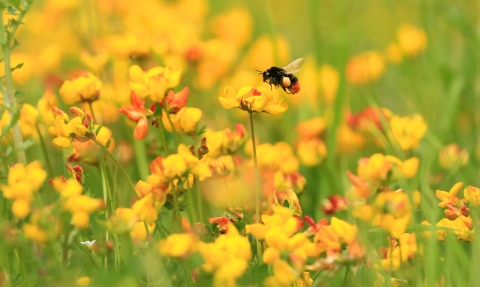
Red tailed bumblebee, Jon Hawkins, Surrey Hills Photography
Get to know your bumblebees
Here are a few helpful hints
With so many different types of bees, where do you begin if you want to start identifying them?
What colour is its tale?
Common bumblebees have tails that are white, red, buff or brown. Colours may fade as the bee gets older and some colours are confined to the tip of the tail, making them difficult to see.
What other bands can you see?
Look at the number, colour and position of bands and then take a look at our handy identification guide below.
Is it a ‘true’ or a ‘cuckoo’ bumblebee?
‘True’ bumblebee workers and queens collect pollen, so they have a back leg that has a broad shiny surface (the pollen basket), or has a ball of pollen stuck to it. Cuckoo bumblebees do not collect pollen, so this part of their leg is narrow and covered in thick dark hair. Male bumblebees’ legs look similar to cuckoo legs, but with fewer hairs.
Is it male or female?
How active are they? Females tend to be much busier flying quickly from flower to flower, while males tend to sit lazily on flowers as they don’t have to collect pollen.
A more accurate way of identifying the sex is by looking closer, males of some species have yellow hair on their faces and longer, thicker, curved antennae. Female antennae are shorter, narrower and tend to be elbowed. Males become common in late summer and autumn, whereas females are present throughout spring, summer and autumn.
Bee identification guide
